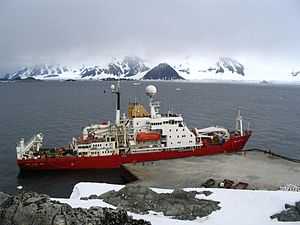RRS James Clark Ross
 RRS James Clark Ross at Rothera wharf | |
| Career (UK) | |
|---|---|
| Namesake: | James Clark Ross |
| Operator: | British Antarctic Survey |
| Builder: | Swan Hunter, Wallsend, Tyne and Wear, United Kingdom |
| Launched: | 1 December 1990 by Her Majesty Queen Elizabeth II |
| Homeport: | Stanley, Falkland Islands |
| Fate: | in service |
| Notes: | [1][2][3] |
| General characteristics | |
| Type: | Research vessel |
| Tonnage: | 5,732 GT |
| Displacement: | 7,767 tonnes (loaded) |
| Length: | 99.04 m |
| Beam: | 18.85 m |
| Draught: | 6.30 m |
| Propulsion: | Diesel-electric Single shaft (8,500 shp); fixed pitch propeller Azimuthing bow and stern thrusters (10 tons and 4 tonnes of thrust, respectively) |
| Speed: | 12 knots (22 km/h; 14 mph) |
| Endurance: | 57 days |
| Capacity: | 1,500 cubic metres of general cargo 250 tonnes of bulk aviation fuel 300 tonnes of diesel fuel. |
| Complement: | 11 Officers and 15 Crew and up to 50 Scientific Personnel |
RRS James Clark Ross is a supply and research ship operated by the British Antarctic Survey.
History
RRS James Clark Ross is named after the English explorer James Clark Ross.[4] She replaced the RRS John Biscoe in 1991.
See also
- RRS Ernest Shackleton, another British Antarctic Survey Royal Research Ship.
- James Ross Island
- Ship's current position
Gallery
-

RSS James Clark Ross outward bound from Portsmouth Naval Base 1 September 2010.
Footnotes
- ↑ "Technical Data - RRS James Clark Ross". British Antarctic Survey. Retrieved 2007-08-20.
- ↑ "BAS Public Information Leaflet - Ships". British Antarctic Survey. Retrieved 2007-11-24.
- ↑ Mike Gloistein. "RRS James Clark Ross". Archived from the original on 2008-04-06. Retrieved 2007-11-24.
- ↑ "RRS James Clark Ross". British Antarctic Survey. Retrieved 2007-11-24.